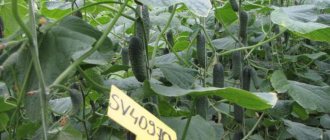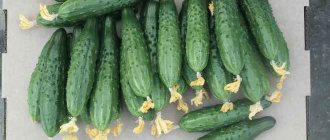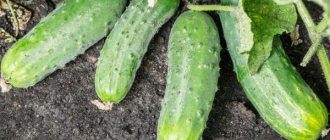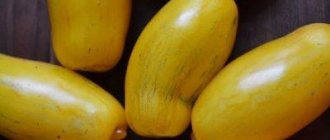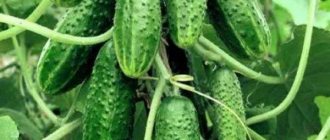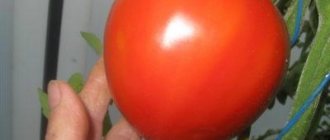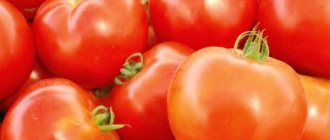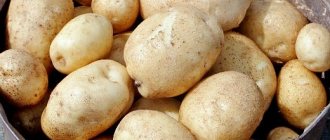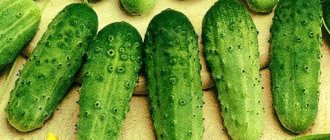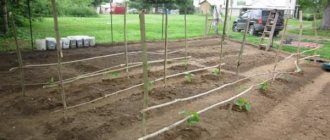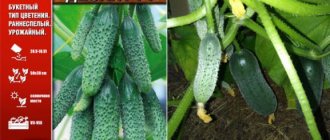Vegetable growing » Cucumbers
0
1958
Article rating
Kira Stoletova
Before choosing a type of culture, we need to look around a little: each has its own qualities, positive and negative sides. The Khutorok cucumber variety is loved by everyone due to its early ripening, and who wouldn’t want to pick something fresh as soon as possible? Some craftsmen grow it in warm loggias and on glazed balconies, pampering themselves with crispy cucumbers in the middle of winter.
Characteristics of cucumbers of the Khutorok variety
Characteristics of the variety
Khutorok cucumber is a bee-pollinated hybrid that flowers primarily female.
However, if you like to experiment and want to grow it at home, you can pollinate it by hand. The fruits are cylindrical in shape, barely tapering to the base, their length ranges from 9-11 cm, and their weight is from 90 to 100 g, their color is green, with white stripes and black spikes, the tubercles are large and have a clear shape. The yield of cucumbers from one plant can reach up to 4.5-5 kg. But these are only the characteristics that the farm cucumber f1 has; we will consider a description of the advantages further.
Advantages
This variety has a lot of advantages that make it so popular among gardeners around the world:
- cucumber has no bitterness, is aromatic, crispy, tasty, this makes it an excellent option for salads;
- rapid maturation. The harvest can be harvested 30 days from the moment the seeds sprout;
- resistance to diseases: root rot, powdery mildew, real and downy;
- tolerates stressful conditions well;
- The Khutorok cucumber variety is universal; it is well suited not only for raw dishes; it makes wonderful pickles and marinades.
- aesthetic appearance, small and neat greens of regular shape decorate the table well and are suitable for curly slicing and complex carving.
Flaws
Like many other cucumbers, they remain vulnerable to diseases:
- Cladosporiosis;
- Sclerotinia;
- Gray rot;
- Anthracnose;
- Alternaria blight;
- Ascochyta and others.
Disease Prevention
Here are some recommendations for preventing them: it will be correct to observe crop rotation for cucumbers, and do not plant the plant in the same place earlier than after 4 years. There is no need to plant the seeds too thickly; the result may not please you. Cold watering can make cucumbers sick, so it is better to leave it in the sun. Regular cleaning of plant debris will only be beneficial; prevent the spread of infections.
Cucumber "Khutorok f1": recommendations for growing and caring
The Khutorok F1 cucumber is undemanding in care, resistant to diseases, and the fruits appear a month after the first shoots. The features of the variety include high yield - each bush produces up to 5 kg of vegetables per season, and resistance to the most common diseases. It has been a leader in sales for several years now and receives positive reviews from those who have tried to plant it on their plot. Suitable for winter preparations.
Plant characteristics
Khutorok F1 cucumbers are a hybrid bred by breeders specifically for cultivation in the weather conditions of the middle zone. The plant is designed to bear fruit successfully on hot sunny days and cloudy, cool weather.
- tall plant;
- leaves of medium size, dark green, slightly drooping;
- low branching;
- blooms according to the female type;
- bee-pollinated;
- it is possible to pollinate in an apartment on your own;
- resistant to powdery mildew, root rot;
- intended for cultivation in open ground or greenhouses;
- tolerates temperature changes well;
- forms abundant ovaries.
Fruit characteristics
The variety is a universal one, which is equally good in pickling whole, sliced, in salads and fresh. Its dense pulp allows it to be used to create decorative compositions for decorating ready-made dishes.
- size – 9-11 cm;
- weight ranges from 70-100 g;
- shape – cylindrical, slightly tapered at the ends;
- rich green color with light stripes;
- on the surface there are pronounced tubercles with dark brown or black spines;
- no bitterness;
- the flesh is dense, crispy;
- resistant to storage and transportation.
Resistance to diseases and adverse
The Khutorok F1 variety was bred taking into account experience in growing cucumbers in the middle zone climate. Therefore, breeders made it resistant to some diseases common in this area. The root system of cucumbers is not susceptible to rot, which allows you to preserve the plant, even in adverse weather conditions. High immunity helps to avoid infection with downy or powdery mildew, which affects most vegetable crops.
The most favorable conditions for growing are daytime temperatures within +23-26 ºС and night temperatures +18-20 ºС. At the same time, the number of ovaries does not decrease if these indicators increase or decrease, which makes it possible to obtain a harvest even with sudden changes in daily temperature.
Features of cultivation
Cucumbers are cultivated in several ways - in open ground or in greenhouse conditions, depending on the climate of the area. If desired, you can plant vegetables on a lit balcony or windowsill. Cultivation of a crop includes several main stages, if followed, a high yield is ensured.
Planting a variety
Seeds are sown at the end of May - beginning of June, in open ground or a greenhouse to a depth of 2-4 cm.
Before this, it will be useful to soak them in water for a day, so the culture will take root more easily. The distance between the holes should be 40 cm, exactly the same as between the rows. Before the first shoots, the crops are covered with film at night to protect them. It is important to remember that this is not a self-pollinating variety and if you are using a greenhouse, be prepared to have to pollinate the flowers by hand.
Soil preparation
Prepared soil will ensure good plant growth
Before planting, experts recommend that you prepare the soil. A good harvest of cucumbers is promoted by well-drained soil, fertilized and rich in nitrogen. Highly acidic soils are limed to avoid crop diseases. For fertilizer you can use 20 kg. manure, 30 g of superphosphate and 10 g of potassium chloride, all mixed well and used per 1 square meter. m. of land.
Reviews
I plant the hybrid only in open ground. The main advantage is the quick receipt of the first harvest. Only a month passes. Juicy and crispy fruits can be placed in the basket. In addition to early fruiting, the hybrid variety has good immunity and resistance to sudden heat and frost.
In the middle zone I plant seeds in early June. The variety "Khutorok F1" produces uneven shoots. The reason is depleted soil and short summer. There are enough cucumbers for personal consumption, but it is useless to grow them for sale. I constantly thin out the soil and apply complex fertilizers.
The variety is suitable for seaming and salads. Ripens quickly. It can be stored for up to 2-3 weeks. I tried to get seeds for planting. The result was mixed. On the one hand, they took root in the greenhouse, but on the other hand, the second generation of seedlings did not receive the immunity of their “parents.” It is more advisable to buy seed material in a store.
The hybrid variety “Khutorok F1” was bred for planting in open ground. Productivity ranges from 4 to 5.5 kg, depending on weather conditions. The vegetable requires minimal care. More attention is paid to the level of acidity and moderate watering. If one of the two indicators is higher or lower than the norm, you should not count on a good harvest.
Bush care
As soon as three leaves appear on the cucumbers, the soil is loosened to feed the plants. Potassium chloride and saltpeter are added, at this stage there will be enough fertilizer, and before the first flower they are fed again. In the future, adding mulch will speed up the appearance of the crop; it will perform a protective function and retain moisture. In addition to mulching, there are other, modern ways to cover the crop; they will be able to transmit the sun's rays and will not allow weeds to easily take over the bed, and will retain soil moisture for a long time. When the cucumber has five leaves, their tops must be pinched off; this is done to increase the number of female inflorescences.
Watering
Cucumber is a moisture-loving vegetable and loves daily watering, done in the evening with warm water, combined with fertilizing once every two to three weeks. So that the cucumbers taste sweet, and water them abundantly during the setting and active growth. An important point will be timely harvesting, otherwise the cucumbers begin to overripe and draw juices onto themselves, preventing the development of new ovaries.
Features of the hybrid
Cucumber variety Khutorok F1 is a super-early ripening hybrid of the bee-pollinated type. It has high productivity. It begins to bear fruit 30 days after germination.
- vigorous, but weakly climbing;
- leaves are medium sized, dark green;
- the type of flowering is predominantly female;
- forms ovaries well;
- yield - 4–5.5 kg per plant;
- immunity to true and downy mildew, as well as to root rot, is developed.
Reviews from vegetable growers indicate that the hybrid variety Khutorok F1 is resistant to temperature changes, fruiting does not stop both at low temperatures and in the sun.
- small cucumbers - length 10–12 cm, diameter 3.5–4 cm;
- oval-cylindrical shape;
- weight from 80 to 100 grams;
- the surface is finely tuberculate, the tubercles are sparse with black spines;
- deep green color with short light stripes;
- The greens are dense and crispy, without bitterness.
Cucumbers of the Khutorok F1 variety are suitable for universal use in cooking. Thanks to their excellent taste and neat shape, they are ideal for salads and canning, as well as for decorating dishes.
Pest treatment
Aphid
The real nightmare of a cucumber garden is the melon aphid; this insect adheres to the plant in entire colonies and feeds on its juices, multiplying until it dies.
The following tinctures are suitable for spraying: tobacco, wood ash with laundry soap, onion and garlic. But in addition to active control, there is one trick that prevents the appearance of the pest: ladybugs significantly reduce their population, in order to attract these beneficial insects, just plant mustard leaves or dill; these plants attract enemies of the melon aphid.
Mite
Spider mites cause great inconvenience in greenhouses, as in the case of aphids, the mite feeds on juices and is excreted in a similar way.
But besides this, digging up the soil for the winter helps a lot, in this case the insects die. Root-knot nematodes can attack roots; this pest is eliminated by replacing contaminated soil with healthy soil, 50 cm deep. In greenhouses, the soil can be treated with steam, or the soil can be frozen in winter by removing a layer of snow. Clean tools are used during the process to ensure that infection does not recur.
Ants
Another enemy of cucumbers can be ants, which dig countless tunnels and bring aphids with them. They get rid of them by regularly digging up the soil, placing special traps with syrup, digging up anthills and filling them with kerosene. In addition, you can dust the ground with slaked lime or pour boiling water into the ant nest.
Advantages and disadvantages
Pros:
- universal application;
- high marketability, transportability;
- keeping quality 10-12 days;
- excellent taste and pickling qualities;
- possibility of cultivation on the site and at home (on the balcony, window);
- good germination;
- resistance to viral and fungal pathogens;
- uniform stable yield;
- independence from the climatic features of the region;
- stress resistance.
Minuses:
- the need for overseeding pollinator hybrids (about 10%).
Video Review
This variety is universal: it is intended for open ground, film shelters, and can also be grown at home. The bee-pollinated hybrid cucumber Khutorok F1 is early ripening - only a month before the formation of fruits, which are used for pickling, pickling and salads. It blooms predominantly with female ovaries. The yield of 1 bush is 4.5-5.5 kg, per 1 m² - from 9.8 to 10.3 kg.
Sowing to obtain seedlings is carried out in the first week of May, and at the end of the month or the beginning of June they are transferred to open ground. The bushes are placed according to a 40x40 cm pattern; they begin to bear fruit in 30-35 days. The plant is moderately branched with medium-sized leaves and short cylindrical black-thorned greens 10-12 cm long, weighing 80-120 g. The tubercles on the cucumber are sparsely located and large, the taste is without bitterness. The hybrid is resistant to powdery mildew, root rot and other stressful conditions.
